ASUS P8P67 Review
by Brendan van Varik on September 8, 2011 10:45 AM EST- Posted in
- Asus
- Motherboards
- P67
LAN Speed Test
LAN Speed Test is a freeware program designed for testing the network connection between two PCs on a home network. The speed of the transfer is limited by the lowest common denominator on the network, so if you have gigabit Ethernet capable computers but a 100 Mbit capable router, you are limit to 100 Mbit transfer. Note that this is really a formality – if a network port is rated at 1 Gbps, then chances are that it will hit at least 90+% of this value. The main test here is CPU usage, and how much is offloaded by the controller. For this test, we use LAN Speed Test to transfer a 1000 MB file across a home network with a 100 Mbps lowest common speed to the same machine each time, in a read/write scenario. CPU usage is taken as a visual max/average from task manager. Note: future LAN speed tests will be at the Gbps level.
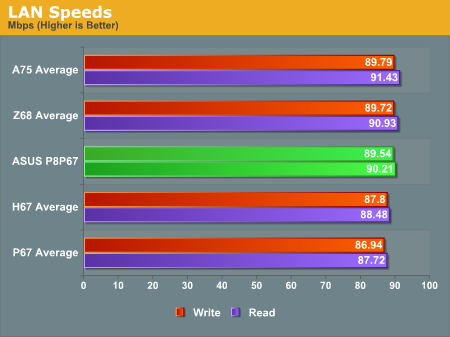
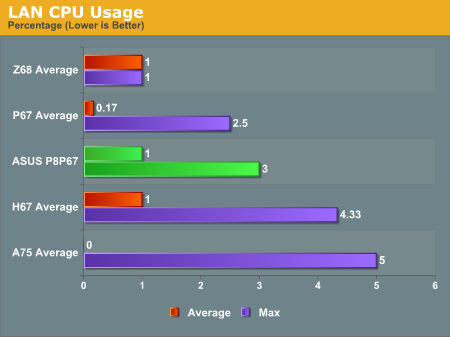
The results on this board are above average so that is a good sign. The CPU usage is low and that means the Realtek controller doing its job so that the transfer does not eat up too much of the systems resources.
DPC Latency
Deferred Procedure Call latency is a way in which Windows handles interrupt servicing. In order to wait for a processor to acknowledge the request, the system will queue all interrupt requests by priority. Critical interrupts will be handled as soon as possible, whereas lesser priority requests, such as audio, will be further down the line. So if the audio device requires data, it will have to wait until the request is processed before the buffer is filled. If the device drivers of higher priority components in a system are poorly implemented, this can cause delays in request scheduling and process time, resulting in an empty audio buffer – this leads to characteristic audible pauses, pops and clicks. Having a bigger buffer and correctly implemented system drivers obviously helps in this regard. The DPC latency checker measures how much time is processing DPCs from driver invocation – the lower the value will result in better audio transfer at smaller buffer sizes. Results are measured in microseconds and taken as the peak latency while cycling through a series of short HD videos - under 500 microseconds usually gets the green light, but the lower the better.
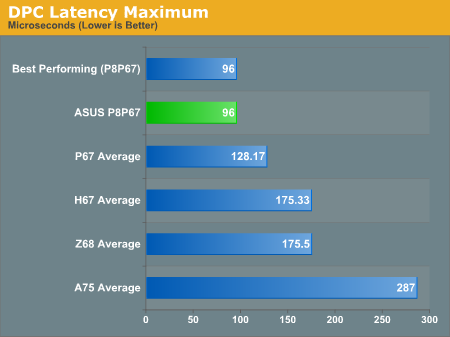
96us is the lowest latency we have had on the Sandy Bridge platform.
USB Speed
For this benchmark, we run CrystalDiskMark to determine the ideal sequential read and write speeds for the USB port using our 64GB Patriot SuperSpeed USB 3.0 drive. Then we transfer a set size of files from the SSD to the USB drive, and monitor the time taken to transfer. The files transferred are a 1.52 GB set of 2867 files across 320 folders – 95% of these files are small typical website files, and the rest (90% of the size) are the videos used in the Sorenson Squeeze test.
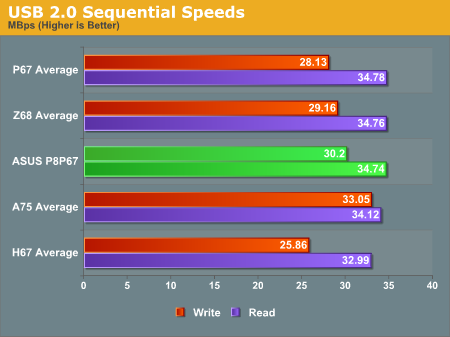
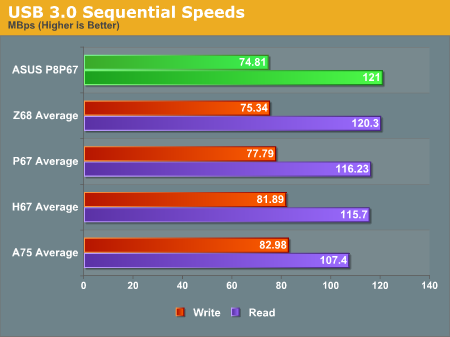

Overall, the P8P67 is only a fraction behind its bigger brother, the P8P67 Pro.
SATA Testing
We also use CrystalDiskMark for SATA port testing. The operating system is installed on the Micron RealSSD C300, which is rated at 355 MBps read and 215 MBps write, and the sequential test is run at the 5 x 1000 MB level. This test probes the efficiency of the data delivery system between the chipset and the drive, or in the case of additional SATA ports provided by a third party controller, the efficiency between the controller, the chipset and the drive.
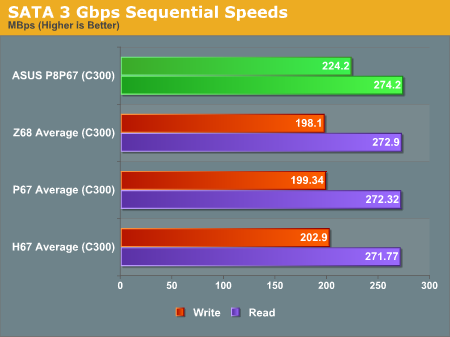

The P8P67 has given us the fastest set of SATA 3 Gbps write speeds we have seen thus far. Strangely enough, it is 25.2 MBps faster than the P8P67 Pro which costs more – however, the P8P67 Pro beats it in read speeds but only by 8 MBps.
Moving on to the SATA 6 Gbps results, the write speeds are good. Second from top is nothing to be sniffed at when you consider the price of the motherboard. The read speeds do not impress as much but they are not the slowest we have seen. It does beat the ASRock Extreme4 and the Gigabyte P67A-UD4 which are both in a similar price bracket but the Gigabyte board does have the upper hand when it comes to read speeds.










52 Comments
View All Comments
ryedizzel - Thursday, September 8, 2011 - link
@Impulses: Saying they might be paid to review an older product is COMPLETELY different than saying they were paid to give it a favorable review.@Etern205: No you don't have the right to spit on their work just because you factory tours and home theater setups more interesting. They do a great job and everything here is free for you, so if you don't like it then gtfo.
Etern205 - Thursday, September 8, 2011 - link
If a site is going down hill then it's going down hill, why are you kissing @ss?!I have my right to express my opinion/complaint as I wish because this site was uber awesome back in the old days. I've entered this field back in 99 and been reading here ever since (Anandtech started back in 97) because it's filled with interesting and fun to read articles that fills every one of my neurons with technical knowledge.
This site became what it is today because of articles that attract enthusiast and power users. If they review consumer based product for the average Joe and Jane, will they ever be here today? I don't think so!
About those tours they're leisure articles and yet still attracts
enthusiast and power users. For Anand's home theater, you should actually take a look at that awesome article before telling others to GTFO.
If you like to read on smartphones and other nonsense products, then there are plenty like Cnet or PCWorld.
Etern205 - Thursday, September 8, 2011 - link
Yep, I yawn at SSD reviews because the main purpose of getting one is to speed up your apps or for those who thinks the sky is falling when they can't wait even a single second!You see reviews on SSD and are amazed by it's blazing speed, is it within your reach? Sure the price of SSD has dropped as you can get a 120GB Crucial M4 for less than $200. While sub $200 is quite a price drop for SSD and it's larger than 64GB, the price is still too high for some.
And who says I can't complain? You work for Anand for what?
This site use to have the most awesome articles, I hope their articles on BullDozer will turn this site around.
Some of the articles I enjoy were the factory tours and especially Anand's personal home theater setup.
JonnyDough - Thursday, September 8, 2011 - link
That's why if you're money savvy you bought a 60GB Vertex II when they were hovering $100 after rebate. :)Amazing2u - Friday, September 9, 2011 - link
Geez... Stop yawning, you're putting me to sleep.I'm happy that Anandtech and it's writers have more diversified articles then "other" hardware sites that only publish boring stuff you see everywhere else.
I happen to like those Smartphone and whatnot reviews.
Keep up the great work! :)
Sim
RussianSensation - Thursday, September 8, 2011 - link
While it's doubtful anyone with a $1500 GPU setup (HD6990 CF) will be using this board, there is nothing wrong with running say HD6870 / 6950 CF on this board. In fact PCIe 2.0 4x produces about a 7-8% penalty for a faster GPU like the GTX480:http://www.techpowerup.com/reviews/NVIDIA/GTX_480_...
Not only that but HD6950 2GB setup in CF is more useful at 2560x1600 too, where PCIe limitation is only around 5% (see link above).
LegitReviews even performed CF testing on this board to show that the difference is not as much as people believe: 2x HD6950s in CF tested in P8P67 (16x/4x) vs. P8P67 Deluxe (8x/8x):
http://www.legitreviews.com/article/1500/9/
The performance difference at 1920x1080 was:
- 5.3% in AvP
- 8.5% in Metro 2033
- 2.9% in STALKER: cop
Certainly not 30-50% less as some people probably imagine. For a budget board around $135, there weren't many boards better.
However, I feel that Asrock has really stepped up their game with:
1) Asrock Z68 Extreme3 Gen3 - $125 on Newegg
2) Asrock P67 Extreme4 Gen3 - $154 on Newegg
I agree with you that AnandTech stopped focusing on motherboard reviews which is a real shame since if you review CPUs, you should also review motherboards since CPUs have to be inserted somewhere :)
Cheers.
Impulses - Thursday, September 8, 2011 - link
Problem with this particular model is there's other equally economic models from other manufacturers that will do 8x/8x... I love ASUS, last three mobos before my current one were ASUS, but lately I think they've been allowing prices to creep up too much and/or introducing too many damn models. Everyone's guilty of the latter, but ASUS is the worst.As far as mobo reviews in general... Meh. I agree that they're a staple of sites like AT, but if it weren't for the P67 recall and the late introduction of Z68 almost every review of this generation of Intel boards would've read the same.
There's just not anything all that exiting about mobo introductions anymore imo, just find a model with the integrated components that you need from your preferred manufacturer amongst the top 4 and look up one or two reviews to make sure it runs and OC reliably. Nothing really earth shattering or new to it... They're almost a commodity now like HDDs for data.
RussianSensation - Thursday, September 8, 2011 - link
Ya, like I said the Asrock Extreme3/4 series are very attractive. But again in the marketplace this board goes for $135 (Newegg) and I am sure it will be below that shortly. For someone who wants to run a single GPU, this $135 board has a lot to offer vs. the competition. You get 12+2 power phases, Bluetooth, the best UEFI imo, and 3 year warranty (of which the 1st year is advanced replacement so they send you a new board first).If you want to run 2 GPUs though, the Asrock Z68/P67 Extreme Gen3 series is far superior for $130-155.
Metaluna - Thursday, September 8, 2011 - link
And that 7-8% performance hit will be on only one of the two GPUs, so it will be even less significant to the overall graphics performance. And, if you put the lower-performing GPU in that slot, the impact is even lower.People really get way too hung up on abstract specs like PCIe lanes without taking time to evaluate what they actually mean in the real world.
gramboh - Thursday, September 8, 2011 - link
This board can be found for about $135CAD right now, really cheap compared to higher end P67/Z68 boards which are $180-220ish.Thanks for posting this, I was interested to see that it could hit 4.7+ GHz overclock.